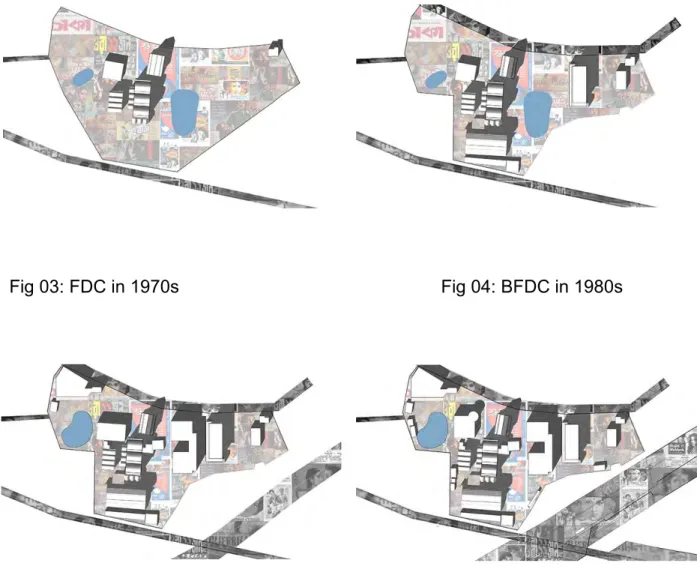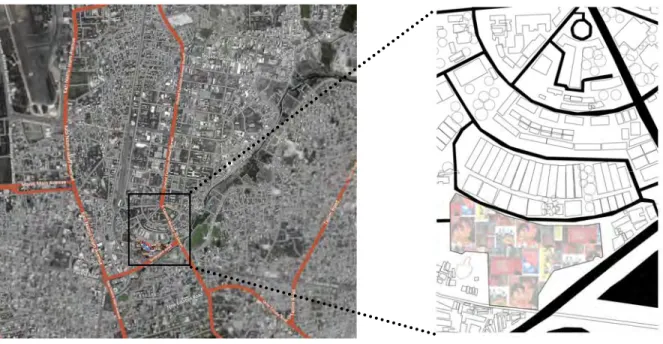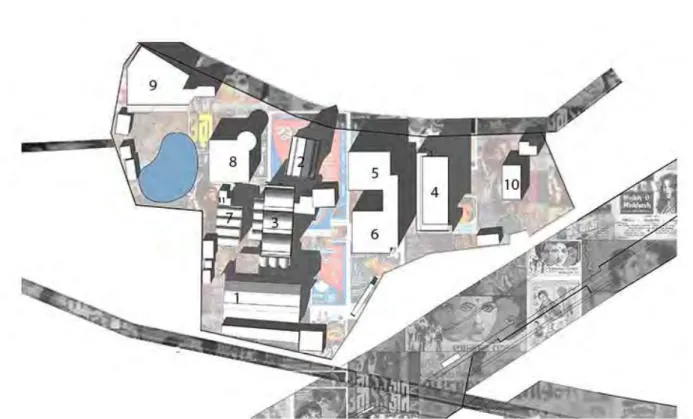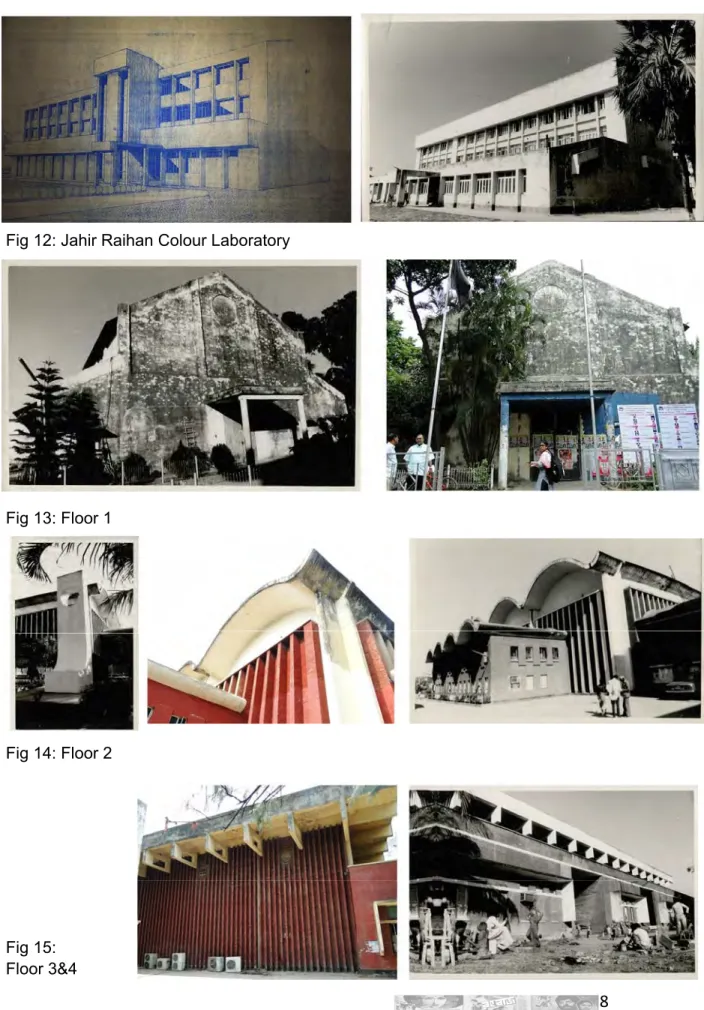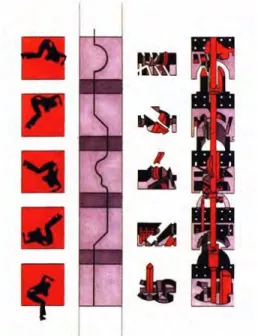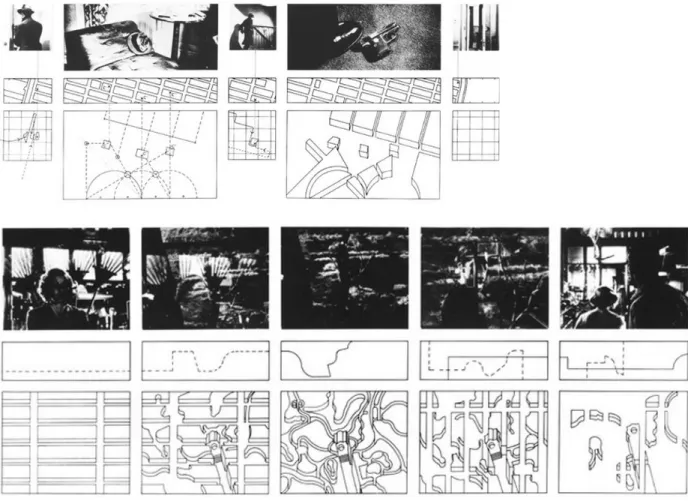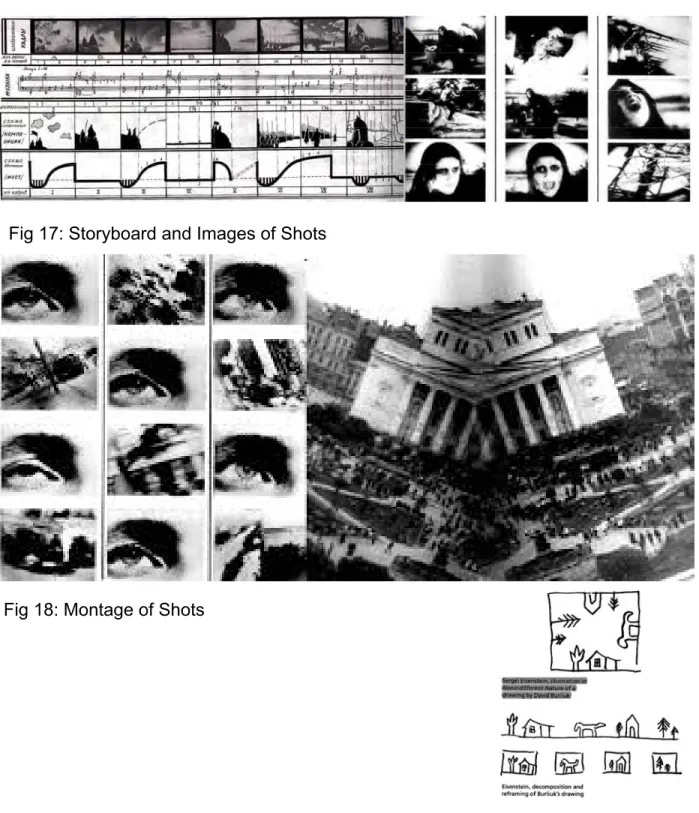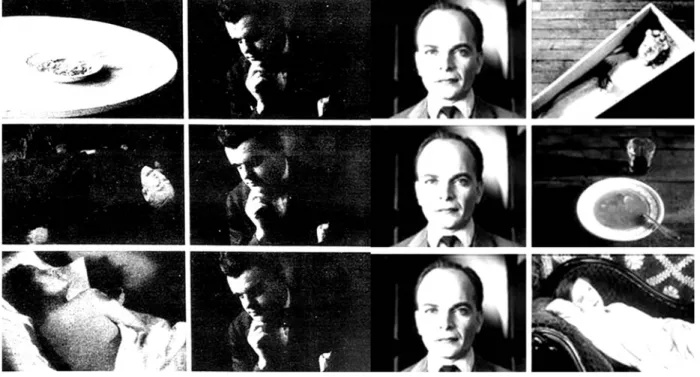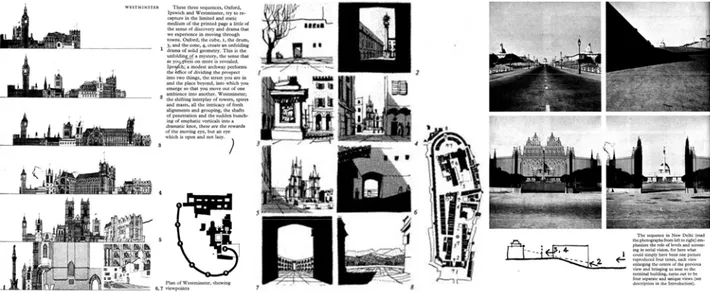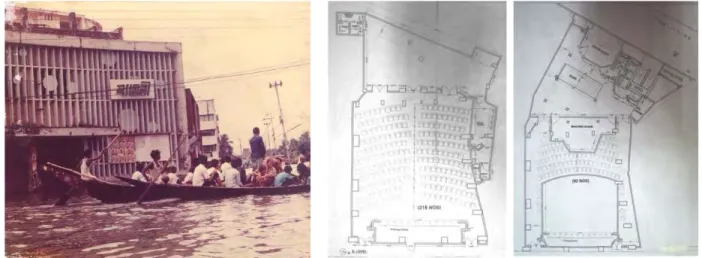Chalachitra Jadu Ghar: Film Museum
Supervised by:
Dr. Mohammad Faruq, Assistant Professor
Dr. Nandini Awal, Assistant Professor
Submitted By:
Farah Jalil
09208019
ARC 512 Seminar II
Submitted in partial fulfillment of the requirements
for the degree of bachelor of architecture
Department of Architecture
BRAC University
Contents
Chapter 01: Introduction
1.1 Background of the Project……….1
1.2 Project Brief……….2
1.3 Aims and Objectives of the Project………..2
1.4 Proposed Program……….3
Chapter 02: Site Appraisal 2.1 Historical and Social Background………4
2.2 Location of the Site………6
2.3 Current Condition of the Site………7
2.4 SWOT analysis………...9
Chapter 03: Literature Review 3.1 Art and Artifacts………10
3.2 Film as an Art………11
3.3 Mies van der Rohe: Through the Lens of Cinema………..12
3.4 The Effect of Film on Bernard Tshumi…………...………...13
3.4.1 The Manhattan Transcripts ...13
3.4.2 Screenplays ...15
3.5 Theory of Montage...16
3.5.1 Sergei Eisenstein...17
3.5.2 The Kuleshov Effect...19
3.5.3 Serial Vision...19
Chapter 04: Case Study 4.1 Local Projects 4.1.1 Shaymoli Cinema Hall...21
4.1.2 Bangladesh Film Archive (BFA), Shahbag... 22
Contents
Chapter 04: Case Study
4.2 International projects
4.2.1 Le Fresnoy Film School...24
4.2.2 Parc de la Villette ...26
4.2.3 Museum of Moving Images...27
4.2.4 Motion Picture Academy Museum...28
4.2.5 Busan Cinema Centre...30
4.2.6 Utrecht Library...32
4.2.7 St. Peter’s Baldachin ...34
Chapter 05: Program and development 5.1 Museum...36 5.2 Film Archive...37 5.3 Administration...37 5.4 Library...38 5.5 Recreational/Common Area...38 Chapter 06: Conceptual stage and Design Development 6.1 Introduction...39
6.2 Concept Development...40
6.3 Final Design Drawings...41
Conclusion
CHAPTER 01
IntroductionA kaleidoscopic story of our celluloid history could only be narrated, exhibited and archived in a museum. A Film Museum could be that bioscope, through whose viewfinder the film lovers, researchers and any Bengali can find, learn and experience the cinematic glory that have spectacled our nation since the making of Mukh O Mukhosh. A film, patterns of light on a screen is an artwork, only when the notion of viewing is achieved through a spectator. These recorded sounds and images when preserved in a film in a canister or even digitally, becomes an artifact. Artifacts includ-ing the props, posters, reels and the history that the cinema of our country holds can be transformed into artworks of their own, only when exhibited and curated in a muse-um. Screening of old and new cinemas, experimental films, documentaries and con-temporary multimedia installations playing along a permanent collection of films like Mukh O Mukhosh, Dhrubo (1934), Pramathesh Barua’s Devdas (1935) could transform a cultural forum into a civic center of the city.
The momentousness of Bengali cinema in our Bengali culture has penetrated deep into the social fabric and the subjective imagination of the masses to a point that it affects every day life. The realization that cinema is not simply a powerful instrument for a convincing representation of reality or for entertaining masses but medium that fundamentally reshapes the existing regimes of vision, perception and knowledge. “ Film: unfolding [result] of all the forms of perception, the tempos and rhythms, which lie preformed in today’s machines, such that all problems of contemporary art find their definitive formulation in the context of film” Walter Benjamin. Film is not only a vehicle for transporting images and narratives, but a material manifestation of time and notion, a platform for rethinking and a medium of modern thought. When these thought are portrayed via a common forum such as a film hub, the masses are not only entertained through films but also empowered both culturally and socially. Thus a film museum and archive could be that platform or an experiential journey from where any Bengali from all walks of life could be proud of the history that we tend to forget and play an active role in the progressive culture of film making.
1.1 Background of the project
The film theory of Montage practiced by Soviet film maker and film theorist Sergei Eisenstein is explored in the architectural expression of a space, accommodat-ing the preservation and glorification of the world of Bengali cinema. The dissertation looks into the works of architects, artists and filmmakers conceptualizing the art of moving images in cinema into architectural thoughts, theories and expression. A muse-um is thus proposed to preserve the cinematic past in dramatic spaces in light of the theory of Montage.
1.2 Project Brief
Project Title: Chalachitra Jadu Ghar: Film Museum
Location: Bangladesh Film Development Corporation (BFDC), Tejgaon, Daka Area: 10.5 acre
Client: Executing Agency: Bangladesh Film Development Corporation, Tejgaon Sponsoring Ministry: Ministry of Information, Government of Bangladesh
1.3 Aims and Objectives Of The Project
When the audience is the people
Witness the metamorphosis of modern thoughts through progressive films.
Engage film enthusiasts.
A visual destination for the public in a form that encompasses the society’s identity.
Become a medium of cultural memory of the people.
Engage the public in an experiential journey of Bengali cinema
When the audience is the city
Create a dialogue between its contents and urban context.
To represent a cultural identity of the city.
Merging the civic space of Hatirjheel Project with entertainment.
To contribute in a strong economic foothold in the film industry
1.4 Proposed Program
Museum — Permanent Gallery and Temporary Gallery
Film Archive and Film Vault
Library
Cine Theatres
Workshops and Seminar/ Lecture Rooms
Amphitheatre Multipurpose Hall Restaurant Cafeteria Administrative Office Souvenir shops
CHAPTER 02
Site Appraisal2.1 Historical and Social Background
After partition, a land at Tejgoan B.G Press was acquired in an effort to estab-lish the first ever film making facilities of then East Pakistan. The petition to estabestab-lish studios and laboratories were in pledge. In 1956 the government announced a 5 year plan to set up facilities for the filmmaking mission. In 1957 Film Development Corpora-tion was established in Tejgaon. The first administrative building was thus built in 1959. In an year FDC could facilitate in making the following films, Ashia, Akash aar Maati, Maatir Pahar, Jago Huya Savera, Ayedesh Tomar Amar and Rajdhanir Booke. The first film studio of FDC was built in 1960, Floor 1. With time FDC grew to facilitate the art of filmmaking by building the first colour laboratory in 1983, Jahir Raihan Colour La-boratory.
Fig 01: FDC in 1959 Fig02:FDC in 1960
Fig03:FDC in 1970s Fig04:BFDC in 1980s
2.2 Location of the Site
Tejgoan was the location for building industries as per guideline of the first mas-ter plan of Dhaka in 1959. The area is surrounded by institutional, commercial, residen-tial and other non-industrial use. A water body previously known as Begunbari Khal on the east side, has been recently transformed into larger water body, Hatirjheel. The Hatirjheel project is recently seen as a great civic space for the busy lives of the Dhaka dwellers and a breathing space of the highly dense Dhaka city. Along this Hatirjheel project, with Sonargaon road as the main access road with two other tertiary roads, the chosen site for the museum is the existing site of BFDC.
2.3 Current Condition of the site
Fig 11: BFDC, Tejgoan
1. Jahir Raihan Coulour Laboratory 7. Floor 7
2. Floor 1 8. Dobly Digital Sound Complex
3. Floor 2 (Jashim Floor) 9. Analogue Sound Complex 4. Floor 3 and Floor 4 10.Editing Complex
5. Floor 8 11.Camera Section
6. Floor 9
Fig12:Jahir Raihan Colour Laboratory Fig13:Floor 1 Fig14:Floor 2 Fig15: Floor 3&4
2.4 SWOT Analysis Strength
Adjacent to the civic space of Hatirjheel Project. The existing civic space is already hosting public activities. The film museum will have an additional pulling force to assemblage of people around the lake.
The site connected via Sonargoan road on the east side.
The site is a well known familiar place to the citizens of the country, as BFDC.
Potential to unfold history to the future generations of film enthusiasts. Inspiring leg-acies of film makers like Jahir Raihan, Khan Attaur Rahman are imprinted on the site.
Weakness
Decreasing vegetation.
Sound pollution from the surrounding road network and commercial hubs.
Oppurtunity
To view it as a heritage site, since the history of Bengali cinema is imprinted on all the shooting floors
Thus converting the site into a museum for public accessibility
Threat
Increase in footprint of new structures would mean cutting down of trees
CHAPTER 03
3.1 Art and Artifacts
Aristotle divided existing things into those that “exist by nature” and those ex-isting “from other causes.” The former include “animals and their parts(…) and the plants and the simple bodies (earth, fire, air, water)”, the latter include “a bed and a coat and anything of that sort, qua receiving these designations, i.e. in so far as they are products of art.” (Physica, Book II, 192 b 9-18). Aristotle makes here a distinction between natural objects and artifacts (“artificial products”, ibid, 192 b 28), and de-scribes the latter as products of the art of making things.
The art of making something involves an intention of a maker or an author. All works of art, music, painting and literary works, should be called “artifacts” because they have authors. In aesthetics, the expression ‘artifact’ has been used widely in this, that works of art are necessarily artifacts (Davies 1991,Levinson 2007). George Dickie’s analysis suggests that a work of art is an “artifact of a kind created to be pre-sented to an artworld public”. Artifacts in a wider sense is a collection of entities be-tween concreta and abstracta, and substantial objects, events and processes. (Cf Thomasson 1999).
An artifact in a strict sense being a hand made object representing a particular culture can become an artwork of that culture when it is perceived by a person. A po-em is only words on paper, a song is just acoustic vibrations, a film, merely patterns of light on a screen. One cannot react to a poem until he/she reads it or dance to a song without hearing it. “Artistic form is best thought of in relation to a perceiver, the human being who watches the play, reads the novel, listens to the piece of music, or views the film. Perception in all phases of life is an activity” (Bordwell and Thompson, 1990). Art-work rely upon this unsettling human mind constantly performing some activity and movement. If the artwork does not leave the perceiver with anticipation, something to imagine and draw conclusion, it only remains as an artifact.
3.2 Film as an Art
The question whether the cinema which is viewed and produced using machine labour and human labor could be considered as an artform. Earlier reasoning of cine-ma to be not a piece of art was that the exhibition was in form of peepshows and circus slide show, and more importantly whether at all it could be worthy of honorific designa-tion of art. Film seemed to be a means of access to art and not an independent art form on its own. However the first philosopher to question the nature of the film as an artwork was Hugo Munsterberg. In his monograph about this new art form, he distin-guished the film from by its technical devices that it employed in presenting the narra-tives. Flashbacks, close-ups and edits were some of the play of techniques that differ-entiates film from theatre (performance arts) as an art form. More than films being art form due to its newer use of technology, what makes a film truly a piece of art is the fact that a viewer get involved into the imaginary characters of a fictional story emotion-ally. The narration of a film goes on to make an expectation about “what happens next”, investing emotion. Delayed fulfillment of an expectation– suspense may produce anxiety or sympathy. Then, even after it ends, one is still left to ponder upon some-thing.
Cinema challenges the mechanisms of formal description and analysis and the set of media such as drawings, photographs and slide projections that are contents of the body of knowledge or way of communication of architects. The French film theorist Jean Epstein put this completely new and different art as “monstrous”. The reason why it is difficult to associate cinema with the methodological approaches of architecture.
3.3 Mies van der Rohe: Through the Lens of Cinema
Mies an avid filmgoer remained silent on the question of cinema unlike the oth-er modoth-ernist architects. Le Corbusioth-er on the othoth-er hand said he used motion picture medium to propagate his architecture (Architecture d’aujourd’hui,1930). He argues that he thinks “as Eisenstein does in his films”. However Mies neither in his architectural work or his written statements of the 1920s show any involvement with cinema. He had little to do with cinematographic projectors, silver screen and celluloid strips, with filmic representations of architectural spaces or architectural incorporations in cinematog-raphy. But yet he had been called a filmmaker. Cinema more than a visual representa-tion, the moving image is a profound shift in the ways the world is perceived, under-stood and communicated. And it is this epistemological dimension, that inspired Mies during the early 1920s. “I never make an image when Ii want to built a house”, Mies van der Rohe whose architectural discourses were altered through the advent of cine-ma.
Mies tried to integrate the lesson of moving image into his work. Architecture for him an “image-machine” that orchestrates the ever changing relationship between ar-chitecture as image and arar-chitecture as built reality. Mies arar-chitecture is perceived from the pint of view of moving subject, the spaces are the “properties of a changing gaze”. The Barcelona Pavilion has been interpreted by scholars as “cinematic poesis in which visitors participated in a performance of self-estrangement and rediscovery on a higher plan of existence”. This effect is argued to be similar to Hans Richter’s surreal-ist film Vormittagspuk (Ghosts before Breakfast,1928) in which Richter exploits the ca-pacity of cinematographic apparatus– by showing slow motions, superimpositions, rep-etitions- “to make miracles and epiphanies a part of everyday life”.
3.4 The Effect of Film on Bernard Tshumi
In Tshumi’s words in Architectural Concepts, “One day, you decide to study ar-chitecture. You learn to draw plans, section and axonometrics; make models; discover structure, materials, and even composition. Still, you feel that there is something miss-ing in much of what you read and learn. You are aware that there is somethmiss-ing missmiss-ing in much of what you read and learn. You are aware that architecture uses sophisticat-ed means of notation– elevation, axonometrics, perspective views, and so on. But you soon realize that they don’t tell anything about sound, smell, touch, or the movement of bodies through space. The limits of my language are the limits of my world”.
3.4.1 The Manhattan Transcripts
The Transcripts are about a set of disjunctions among use, form and social val-ues. The non-coincidence between meaning and being, movement and space, man and object is the starting condition of the work. Yet the inevitable confrontation of these terms produces effects of far-ranging consequence. Ultimately, the Transcripts try to offer a different reading of architecture, in which space, movement and events are in-dependent, yet stand in a new relationship to one another, so that the conventional components of architecture are broken down and rebuilt along different axes.
“The insertion of any additional space sequence can change the meaning of the Sequence as well as its impact on the experiencing subject as noted Kuleshov experiment, where the same shot of the actor’s impassive face is introduced into a variety of situation, and the audience reads different expressions in each successive juxtaposition.”
3.4.2 Screenplays
The theoretical project in 1976 of Tschumi’s had cinema as the unparalleled source into developing a contemporary set of architectural tools. The rich formal and narrative inventions of the only genuine 20th century art inevitably encouraged paral-lels with current architectural thought.
Flashbacks, crosscutting, jumpcuts, dissolves and other editing devices provid-ed a rich set of analogies to the time-and-space nature of architecture. Yet the con-cerns of the screenplays were essentially architectural. They dealt with issues of mate-rial (generators of form: reality, abstraction, movement, events, and so forth), device (disjunction, distortion, repetition and superimposition) and counterpoint (between movement and space, event and space for example).
3.5 Theory of Montage
That montage– the appropriation and assembly of individual production in mo-dernity. In an architectural context, montage first referred to anonymous industrial pro-duction based on the assembly of pre fabricated parts, and it is for this reason that it became a guiding principle for standardization, industrialization and mass production in modern architecture. However, the principle of montage may not be reduced to such a technical procedure; rather, montage was soon exploited in the sense of an aesthetic category whose impact depends on dialectical juxtaposition and shock. The theoretical foundations for such an aesthetic understanding of montage were laid out mainly by film theorists such as Sergei Eisenstein (himself an architect by training) and Dziga Vertov, a Dadaist artist circle in Berlin around 1920s. Later on, Walter Benjamin in his Arcades Project theorized montage as the structural principle for a materialist historiog-raphy. Sergei Eisenstein, who defined the term MONTAGE and was it’s most passion-ate defender, practiced what is known as dialectical montage. The shots appear to col-lide forcing a viewr to engage their powers of reason to create the necessary connec-tions that bring meaning. A film can present a fragmented data set with confidence, as the human mind has no choice but to construct a whole. In “Art in Age of Mechanical Reproduction”, Walter Benjamin said that talkies and architecture were bth art forms received passively, but Eisenstein clearly believed that this passivity could be disrupt-ed through the perpetual interjection of discontinuous imagery forcing the spectator to “mount” each successive shot.
Montage is not simply the technique of cutting shots together, it is a dynamic system for expression of ideas.
3.5.1 Sergei Eisenstein
A pioneering Russian film director and theorist Sergei Eisenstein (architect by training) demonstrated the technical, aesthetic, and ideological potentials of montage. Eisenstein believed that film montage could create ideas or have an impact beyond the individual images. Two or more images edited together create a “tertium quid” (third thing) that makes the whole greater than the sum of its individual parts. The concept of montage is defined by the action of fragmenting reality and then reassembling it under the principle of a conflictive order. By juxtaposing two contrasting, disjointed elements a new meaning is created, something that transcends them both and the reality from which they arise. Eisenstein's greatest demonstration of the power of montage comes in the "Odessa Steps" sequence of his 1925 film Battleship Potemkin. For him, a re-lentless vertigo is determined from the architectural forms interacting with each other. Eisenstein’s intention was for arhitectual representations of space to explode into suc-cessive stages of montage from decomposition to recomposition as though it were an array of “shots”. From this, Eisenstein claimed that principles of montage are embodied by architecture. In "Montage and Architecture" by Eisenstein, he sets out this theory. Two paths of spatial perspectives are contrasted, where the viewer follows an imagi-nary line created among a series of objects. "Varying positions moving in front of a spectator" and the architectural, "where, the viewer moves through an array of carefully positioned elements which he has viewed in order with a visual sense.
Eisenstein claims that the perspective path of the Acropolis constructed by Au-guste Choisy depicts composition of the site. He asks the reader to view it with the eye of a film maker. Eisenstein claims there are carefully sequenced perspectives here. He suggests that there is a relationship between the viewer's pace of movement and the rhythm of the buildings. To him, Choisy has set up a combination of a film shot effect, producing new impressions from each new emerging shot. This creates according to Eisenstein a montage effect, where effect is gained from sequential juxtaposition of these shots. In the movie "street" Eisenstein shows his interest of cause and effect as a notion of movement. Shots are decomposed and recomposed. Architectural compo-sition is compared to cinematic montage by Eisenstein in an essay on two Piranesi
engravings for the early and late states of the Carceri series. "The flux of form which contains the potential to explode into a series of successive states" Eisenstein's theory of space constructions depicted new ideas of architecture as frozen music. Eisenstein compared the basis of architectural composition, massing and the establishment of rhythmic elements to that of music, painting and cinematic montages.
Fig 17: Storyboard and Images of Shots
3.5.2 The Kuleshov Effect
Technique which demonstrates the inherent power of montage as a primary tool in the manipulation of the viewer’s perception. According to Kuleshov, cinema consists of fragments and it is their combination rather than their content that is essential in evoking and triggering different emotions. His original experiment consists of using the same shot of the character’s face, frozen in a neutral emotion while editing it next to different objects he appears to be glancing at: a girl in a coffin, a bowl of soup, and a woman. The audience interpreted the three situations as expressions of sadness, hun-ger and lust.
Fig 19: Kuleshov Effect
3.5.3 Serial Vision
Described as the pedestrian experience of the urban space, which can be recorded sequentially by means of drawings, diagrams and photographs. Each movement along the path unravels different views which add to the sense
Buildings are appropriated in a twofold manner: by use and by perception-or rather, by touch and sight. Such appropriation cannot be understood in terms of the attentive concentration of a tourist before a famous building.
On the tactile side there is no counter part to contemplation on the optical side. Tactile appropriation is accomplished not so much by attention as by habit. As regard archi-tecture, habit determines to a large extent even optical reception. The latter, too, oc-curs much less through rapt attention by noticing the object in incidental fashion.”
CHAPTER 04
Case studyA culturally prosperous country like ours is devoid of a museum dedicated to the cinema world. Case studies of museum of films from abroad have been looked into to get a general idea.
The dissertation consists of individually exploring and studying case studies against the notion of montage in architecture.in order to conclude the establishment of the relationship between film and architecture.
4.1 Local Projects
4.1.1 Shyamoli Cinema Hall
Location: Shyamoli, Dhaka
Program: 214 seats cinema hall, cafe
The history: A cinema hall growing into a landmark of Dhaka city, Shaymoli cinema
hall established in 1976, initially with 1800 seats has been a regularly visited hall for decades now. Developed into a Multiplex, now featuring completely digital
cinematog-raphy, showing 4 cinemas in a day.
4.1.2 Bangladesh Film Archive (BFA)
Bangladesh Film Archive is a national institution of Bangladesh entrusted with the preservation of film and film materials and conducts research programs to foster the film environment. The organization established in 1978 under Ministry of Information, Government of Bangladesh is also enrolled as a member of International Ferderation of Film Archive (FIAF) in 1980.
Functions of BFA:
To collect films and allied materials from home and abroad.
To preserve collected films and materials in to the Film Vault under controlled
temperature.
To print and re-print the rare films and classic films.
To check and clean of collected films regularly for long-term preservation,
Research and education.
To collect and preserve the film related books, journals, publications, song books,
posters, leaflets, still photograph, scripts and other materials.
To arrange film show regularly from the collected films.
To create the opportunity to study for the film students in the Archive and specific
film related library.
To arrange film related Seminar, Symposium, Workshop, Meeting etc.
To arrange film festival abroad with native film and in the country with foreign film.
To arrange film related research and publications.
4.2 International Projects 4.2.1 Le Fresnoy Film School
Location: Tourcoing, France
Client: The National Studio for Contemporary Arts Architect: Bernard Tschumi Architects
Area: 100,000 Square Feet
Program: art school, studio, digital laboratory, library for film students and industry professionals.
The idea: The building, which centers on the concept of the “in-between,” com-bines a 1920s building with a contemporary structure with no nostalgic preference for history and no progressive one for modernity: the two pieces are entirely intertwined to become a new mega structure. The old structure is literally wrapped by a new roof and the resulting building gives the impression of movement and circulation. The building often seems to be created out of staircases, ramps and catwalks – a per formative con-struction that communicates exactly its role as a space of sophisticated and experi-mental mechanical systems.
The north face of the mega structure is wrapped in the same language and material of the roof. As such, the project questions the need for normative hierarchies of wall, floor and roof and provides another architecture and space between the multiple layers of building, roofs, catwalks, trusses and skylights. These spaces are populated with cafes, bleachers for projecting and watching movies, over-scaled spiral stairs, and en-try ramps marked by a monumental ‘Eisenstien stair’ of steps and bleachers with an entropic dissolve of metal mesh with a moiré graphic reading Le Fresnoy.
4.2.2 Parc de la Villette
Location: Paris, France
Architect: Bernard Tschumi Architects Area: 125 acre
Program: a social and cultural park with activities that include workshops, gymnasium and bath facilities, playgrounds, exhibitions, concerts, science experiments, games and competitions, in addition to the Museum of Science and Technology and the City of Music on the site, open-air movie theater for 3,000 spectators
The idea: “in the park, the city is not supposed to exist.”
4.2.3 Museum of Moving Images
Location: 35 Avenue at 37 Street, Astoria, New York, USA
Architect: Leeser Architecture Area: 47,700 Square Feet
Program: 264-seat theatre, 68-seat screen room, 4,100 sqft of gallery space, 1,700 sqft Video Screening Amphitheater, gallery for changing exhibitions, experimental production studio, media labs, café Exhibits: screen culture artifacts, digital media installations, 13,000 objects
The idea: a space designed as a capsule for the imaginary voyage of movie going
Fig 26: Plan Drawings
4.2.4 Motion Picture Academy Museum
Location: Wilshire Boulevard, Fairfax Avenue, Los Angeles
Client: The National Studio for Contemporary Arts Architect: Renzo Piano, Zoltan Pali
Area: 290,000 Square Feet
Program: a mixture of galleries, temporary exhibition spaces, event venues, 144- seat theatre, a living-storeroom, the globe, dirigible, or soap bubble, attached to the northern side of the building will house a premiere-sized theatre underneath a glass-covered rooftop venue offering vistas stretching from the Hollywood sign to the Pacific Ocean on ground level, a wide public piazza will stretch underneath the dome and through the ground floor of the building, connecting the museum to the LACMA campus and the city
Exhibits: theatre, which will screen experimental, independent and foreign films various items of movie paraphernalia, such as props, scripts and posters
The idea: “the worlds premier museum dedicated to exploring and curating the history and future of the moving image”
“This glass dome is our architectural manifestation of another world,
because cinema is about taking you to another world”, Pali said, “Streamline Modern architecture involves stripping down the ornament of Art Deco—it starts expressing strength and transportation, and has
the sensibility of large ocean liners…What we’re doing with the theater and large glass dome is about the same thing—it’s about
the sense of flotation and going somewhere.”
Fig 28: Section Render
4.2.5 Busan Cinema Centre
Location: South Korea
Architect: Coop Himmelb(i)au Area: 290,000 Square Feet
Program: 4000-seat outdoor cinema, indoor cinema hall, theatre, a Red Carpet Zone, a Walk of Fame, Memorial Court event plaza, convention halls, office spaces, creative studios, restaurant
The idea: “White the movie theatres are located in a mountain- like building, the centre’s public space is shared between an outdoor cinema and a huge reception area”
“Light as art, which is at the very nature of cinema, creates a unique and memorable atmosphere for the public urban plaza”
Fig 31: Ground Floor Plan Fig 32: Second Floor Plan
4.2.6 Utrecht Library
Location: Utrecht, The Netherlands
Architect: Weil Arets Architects Client: University Utrecht Area: 3,90,192 Square Feet
Program: library, lecture rooms, desks, bookshelves and archives
The idea: “While the Utrecht library is a strange, enigmatic building, everything functions as it should. However, the building raises questions rather than providing an-swers. In that sense, the library is a form that thinks. Through the alienating affects of the abstraction, the black, grey and red, and the photos etched in the concrete and on the glass, it is as though the viewer has landed in a crime novel in which any casual fact or object operates as a clue to a possible murder. In a film the most everyday things suddenly become signs, and every sign leads to another sign because of the desire to see and to know what is going on. This– what Walter Benjamin called the psychoanalysis of viewing– applies not only to film but also to the library in Utrecht. This alienating technique of the thriller can be combined with the technique of mon-tage. Montage stimulates the logic of imagination by experimenting with the associa-tion between two images. Aret’s library makes little use of the montage principle. Aret’s library emphasized instead the emptiness that we know from films like Dogville by Lars von Trier, in which the white chalk lines on the black asphalt indicate in abstrac-tion and essence what the village looks like, or from the photographs by artist and pho-tographer, an architecture without side-effects, lacking in human traces and additions. In Demand’s photographs you have to find the point at which the story of the photo-graph comes to life; in the same way, the Utrecht Library only comes to life when it is occupied by people and books. The movement of life gives the building color; the building itself if monochrome. It does not fill life in, it invites it. The immobile enigma of the structure makes your heart beat faster. It is a building like a school blackboard waiting for traces of life.
If you look closely, you can see that Demand’s photographs of everyday locations are made of paper models. Every detail that might indicate what is going on has been re-moved from sight. As in the case of the railings in Aret’s library, details are invisible. You cannot see how the railing is attached to the floor. Walls, windows’ and doors seem to have been set cold next to one another without the mediation of complicated joints. Floors and ceilings are treated as pure surfaces.
Cameras, cables and lighting, air conditioning, and other attributes that could disturb the total picture have been removed form the sight. What counts is the abstraction, the purity of the material, the construction and the volume, and the roughness of the black – all to provoke the mystery of life ”.(Rethinking Representations by Penelope Dean)
Fig 35: Ground Floor Plan
4.2.7 St. Peter’s Baldachin
Location: St. Peter’s Basilica, Vatican City
Artist: Gian Lorenzo Bernini Dimension: 20m(66ft) Type: Scuplture
The History:
St. Peter's Baldachin (Italian: Baldacchino di San Pietro) is a large Baroque sculpted bronze canopy, technically called a ciborium or baldachin, at the St. Peter's Basilica in the Vatican City.The baldachin is directly under the dome of the basilica and under its canopy is the high altar of the basilica, marking the place of Saint Peter's tomb underneath in a monumental way. The baldachin acts as a visual focus within the basilica; it itself is a very large structure and forms a visual mediation between the enormous scale of the building and the human scale of the people congregating for religious ceremonies.
The form of the structure is in Baroque style of the traditional ciborium or architec-tural pavilion found over the altars of many important churches, and ceremonial canopies used to frame a sacred spot. With twisted Solomonic columns, the traditional cloth canopy known as a baldacchino is located in the center of the crossing. The congregation had a perspective view down the nave to the image framed by the baldachin which com-pressed the distance between the crossing and the Chair of Saint Peter.
Four marble plinths form the basis of the columns that support the baldachin. The two outer sides of each plinth are decorated with the Barberini family's coat of arms. This series of eight, nearly identical coats of arms forms a narrative that has attracted over the centuries the interest of writers and art historians. The coat of arms itself represents the three bees of the Barberini family. The allegory behind the coats of arms is unanimously interpreted as representing the various stages of childbirth.
As Witkowski writes: "The scene begins on the face of the left-hand front plinth; the woman's face begins to contract; on the second and following plinths the features pass through a series of increasingly violent convulsions. Simultaneously, the hair becomes increasingly disheveled; the eyes, which at first express a bearable degree of suffering, take on a haggard look; the mouth, closed at first, opens, then screams with piercing realism. ... Finally, comes the delivery: the belly subsides and the mother's head disap-pears, to give way to a cherubic baby's head with curly hair, smiling beneath the un-changing pontifical insignia.”
The childbirth sequence in Bernini's plinths was praised, among others, by direc-tor Sergei Eisenstein, who in a piece titled Montage and Architecture written in the late 1930s describes it as "one of the most spectacular compositions of that great master Bernini.", with the coats of arms as "eight shots, eight montage sequences of a whole montage scenario."
CHAPTER 05
Program and Development
5.1 Museum SPACE SPACE REQUIRED PER PER-SON (SQ-FT) NO. OF USERS SPACE REQUIRED PER ROOM (SQ-FT) NO.OF ROOMS AREA REQUIRED (SQ-FT) LOBBY (RECEPTION + IN-FORMATION DESK) 6.5 200 1300 PERMANENT EXHIBITION SPACE 10000 TEMPORARY EXHIBITION SPACE 7000 STORAGE 1000 RETAIL AREA 500 WASHROOMS 160 2 320 SUBTOTAL 20120 CIRCULATION (30%) 6036 TOTAL 26156
5.2 Film Archive 5.3 Administration SPACE SPACE REQUIRED PER PER-SON (SQ-FT) NO. OF USERS SPACE REQUIRED PER ROOM (SQ-FT) NO.OF ROOMS AREA REQUIRED (SQ-FT) LOBBY 6.5 50 325 FILM VAULT 1 890 SCREEN ROOM 2.5 92 1 916 STORAGE 500 WASHROOMS 160 2 320 SUBTOTAL 2951 CIRCULATION (30%) 885 TOTAL 3836 SPACE SPACE REQUIRED PER PER-SON NO. OF USERS SPACE REQUIRED PER ROOM (SQ-FT) NO.OF ROOMS AREA REQUIRED (SQ-FT) DIRECTOR 300 2 600 CURATOR 300 1 300 STAFF 80 6 480 CONFERENCE ROOM 20 15 1 300 WASHROOMS 160 2 320 SUBTOTAL 2200 CIRCULATION (30%) 660 TOTAL 2860
5.4 Library
5.5 RECREATIONAL/ COMMON AREA
SPACE NO. OF USERS SPACE REQUIRED PER ROOM (SQ-FT) NO.OF ROOMS AREA REQUIRED (SQ-FT) LOBBY 200
CHECK AREA AND
LOCK-ER 200 READING AREA 90 1 1500 BOOK STACK 20,000 (books & scripts) 1 2000 WASHROOMS 160 2 320 SUBTOTAL 5220 CIRCULATION(30%) 1566 TOTAL 6786 AUDIO-VISUAL 800 LIBRARIAN’S ROOM 2 100 2 200 SPACE SPACE REQUIRED PER PERSON (SQ-FT) NO. OF USERS SPACE REQUIRED PER ROOM (SQ-FT) NO.OF ROOMS AREA REQUIRED (SQ-FT) MULTIPUPOSE HALL 10 200 1 2000 LOUNGE 1000 RESTAURANT 18 150 2700 CAFETERIA 15 100 1 1500 WASHROOMS 160 I 80 2 480 SUBTOTAL 9780 CIRCULATION(30%) 2934 TOTAL 12714 KITCHEN 2100
CHAPTER 06
Conceptual Stage and Design Development 6.1 Introduction
“The world of cinema was the first to introduce discontinuity
a segmented world in which each fragment maintains its own
independence, thereby permitting a multiplicity of combinations.
At one point in ‘The Golem’, the street is filled with a cheering crowd;
later on, it’s strewn with dead bodies. It’s not quite the same street
in the two versions.
The screenplay in the film begins to seem like an architectural
program, describing a set of activities and their relationships.
If the ‘site’ of the film is the street, then it’s space is defined by
what happens in it. You begin to realize that, as an architect,
you will be writing programmatic screenplays of sorts,
as if anticipating potential events.”
Bernard Tschumi / Architectural Concepts
The world of filmmaking encompasses a wide variety of disciplines: scriptwriting, story-boarding, set design, location scouting, camera operating, camera movement, framing, editing, compositing, post-production, lighting, directing, acting and so on. One could find conceptual opportunities for architecture in any of these fields thus being exposed to an infinite amount of possibilities and experimentations. The conceptualization of the project was narrowed down to the aspect of Montage practiced and pioneered by the filmmaker Sergei Eisenstein. The Swiss architect and theorist Bernard Tschumi, in his essay “Sequences” draws upon Montage theory of filmmaking to argue that we experi-ence buildings much the same way as we do films. “When the generation of Michael Graves was drawing, the reference point was paintings,” he says. “My reference point has always been filmmaking.”
6.2 Concept Development
Fig Concept Sketches
Conceptualizing Eisenstein’s theory of montage in this project, it was sought to juxtapose curvilinear lines and surfaces against the orthogonal lines. The orthogonal lines generated from the existing buildings within the site are necessary since the jux-taposed curvilinear lines introduces and architectural analogue to the cinematic mon-tage that disrupts that temporary stability. An unpredictable variety of functions are se-quentially connected via assemblage of different special voyages.
6.3 Final Design Drawings
Fig 39: Sec
tion
Conclusion
The medium of cinema is not only perceived as variant of photography or the inception of theatre architecture. Cinema is perceived as a fundamentally new medium leading to a cultural shift which penetrated deep into all areas of modern life, altering the parameters of perception and thought. In the light of the words, that cinema has the power to alter perception and thought, the project of building a film museum could have a similar impact upon the film enthusiasts and movie goers. The conceptual pro-ject designed in respect to Sergei Eisenstein’s theory, was an attempt and an experi-ment to give a film theory an architectural expression with the hope to create spaces for film enthusiasts or any Bengali, where they would re-invent themselves as culturally and socially enlightened citizens of the nation.
Reference
Habilitaion and Reserch Project Montage in Architecture, http:// www.ursprung.arch.ethz.ch/habilitations/montage-in-architecture
The Effect of Film on Bernad Tshumi, http://architectsandartisans.com/ index.php/2012/11/the-effect-of-film-on-bernard-tschumi/
http://www.ukessays.com/dissertations/architecture/architects-role-in-designing-museums.php
